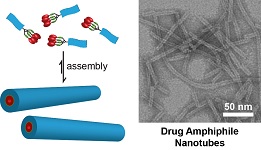 |
| Self-assembling chemotherapy molecules--Courtesy of Cui Lab, Johns Hopkins |
To overcome obstacles associated with the synthetic delivery of cancer drugs, researchers at Johns Hopkins University have found a way to turn the drugs themselves into delivery vehicles.
By organizing the molecules that make up chemotherapy drugs into isolated nanostructures, the researchers have devised a way to potentially bypass the use of synthetic carriers altogether. Synthetic materials, such as those used to encapsulate toxic cancer drugs, come with several drawbacks, including inconsistent dosing and the possible toxicity of the material itself. Thus, the new method would deliver pure chemo to the specified target without the unintended side effects, the scientists say.
To mimic the way other small particles act in the body, Honggang Cui and his team had to cluster the drugs by making them part water-soluble and part insoluble, a characteristic that allows particles within the human body to remain intact, according to a study in the Journal of the American Chemical Society. The team of molecular engineers has received funding from the National Science Foundation.
"The loading within the nanostructure is defined by the molecular design," Cui told Phys.org. "If the drug fraction within the designed molecule is 10%, the nanostructure will have 10% drug loading as well. Therefore, through molecular design, one can precisely tune the drug loading in the nanostructure."
Cui said that the self-delivering drugs could make it into the clinical setting once the team figures out how to further manipulate the behavior of their assembly.
- here's the Phys.org report
Related Articles:
Nano-delivered cell gatekeepers can improve drug performance, study finds
Cholesterol 'rafts' enable cancer-killing delivery of DNA, RNA
Analysts expect nanotech drug delivery boom despite safety concerns